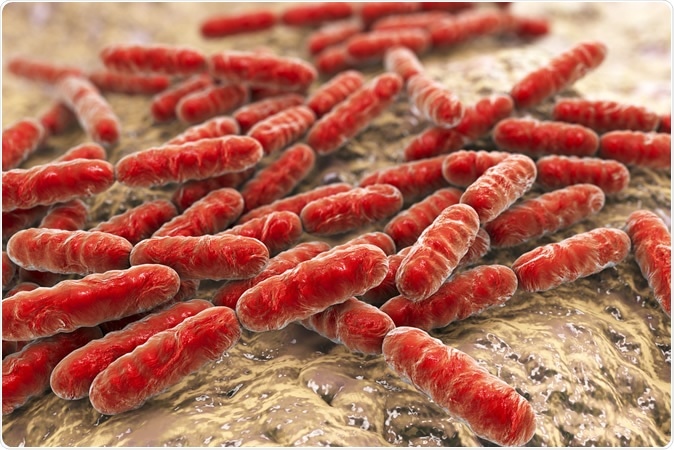A new study shows that something as simple as a cervical swab might have the potential to help hundreds of women who are at extremely high risk of ovarian cancer because they have a mutation in the BRCA1 gene.
These women have been shown to have significantly fewer numbers of one type of protective bacteria, called Lactobacillus, in the birth canal, in addition to having a higher risk of ovarian cancer. Women who already have ovarian cancer are also known to have lower populations of these bacteria. The most marked reduction below normal bacterial counts is found in younger women in both groups.
For the first time, this study showed a link between the presence of a gene mutation and the vaginal bacterial populations. Moreover, it suggests that a simple non-invasive test could help reduce the risk of ovarian cancer.
The study, published in the Lancet Oncology, was carried out by researchers from the University College of London. The researchers looked at samples of cervical smears from 580 women across various countries in Europe, namely, Germany, Italy, Norway, the UK, and the Czech Republic. The age group varied from 18 to 87 years. The women belonged to one of three groups: those who had ovarian cancer, others who were BRCA1-positive and therefore at high lifetime risk for ovarian cancer, and women who had neither ovarian cancer nor the mutation.
Among the women in the first group, Lactobacilli composed less than 50% of the vaginal microbial population (the vaginal microbiome) in 60% of patients. Lactobacilli are important because they produce lactic acid which reduces the pH of the vagina, preventing hostile bacteria from overgrowing and dominating the vaginal microbiome.
Women in the second group (BRCA1 carriers), who had the high-risk BRCA1 mutation but not ovarian cancer, had on average a three-fold reduction in Lactobacillus numbers. In this group, over 25% women under the age of 30 years showed this sharp decrease in Lactobacillus population, compared to same-age women who lacked the mutation. Women with a close family history of ovarian cancer also showed fewer numbers of Lactobacilli.

Bacteria Lactobacillus, lactic acid bacteria which are part of normal flora of human intestine and are used as probiotics and in yoghurt production, 3d illustration Credit: Kateryna Kon / Shutterstock
On the other hand, the women in the low-risk third group had vaginal microbiomes which were predominantly composed of Lactobacillus.
The study indicates a potential link between the loss of these bacteria and the risk of ovarian cancer. The mechanisms responsible for such a link are unknown currently. It could be that the imbalance in the vaginal microbiome reflects a disease process in other parts of the woman’s reproductive organs, including the site of origin of most ovarian cancers in the fallopian tubes. Or it may be true that microbiome imbalance causes inflammation which is a known predisposing factor for cancer development. It is equally possible that observed abnormalities in the vaginal bacteria are just a marker of another background change which is the real cause of the increase in cancer risk.
If the findings are confirmed, then it is likely that new ways of introducing the Lactobacilli into the vagina will be devised to reduce the risk of ovarian cancer. If so, this could be a very easy way to reduce the risk for a very deadly condition.
The current population risk for ovarian cancer is about 2%, but in women with the BRCA1 mutation it is as great as 40% to 60%. The risk of developing breast cancer is also elevated in these women. As a result, many of them choose to undergo a preventive bilateral mastectomy (removal of both breasts) and bilateral ovariectomy (removal of both ovaries) at a very young age, as in their twenties. This has both psychological and physical impacts on their health, besides preventing any chance of normal conception and pregnancy.
Such interventions could help women at high risk safely delay such decisions to a significantly later stage to reduce their sequelae. For instance, women could choose to try to complete their families naturally before opting for ovarian removal. As one patient, Hayley Minn, said after having a preventive mastectomy, “I do want children. So anything that buys me more time and reassures me that ovarian cancer isn’t developing, is a game-changer for me.”
Martin Widschwendter, head of the department of Women's Cancer at UCL, commented: “This is a novel approach and could revolutionize the way that we can intervene and change the implications of being at high risk of ovarian cancer development.”
Source:
Journal reference:
Association between the cervicovaginal microbiome, BRCA1 mutation status, and risk of ovarian cancer: a case-control study, Lancet Oncology, DOI: https://doi.org/10.1016/S1470-2045(19)30340-7, https://www.thelancet.com/journals/lanonc/article/PIIS1470-2045(19)30340-7/fulltext#